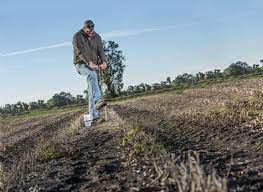Fall Soil Fertility Sampling
By Laura Lindsey, Emma Matcham, Steve Culman, Adapted from C.O.R.N. 2021-37
The fall is a great time to collect soil samples to identify any needs for lime, P, and K. Soil sampling either this fall or spring 2022 will be particularly important with the high costs of agricultural inputs. If soil test P and soil test K levels are within the maintenance range it is extremely unlikely that there will be a yield response with additional fertilizer application. For more information on the state soil fertility guidelines, see the newly revised ‘Tri-State Fertilizer Recommendations for Corn, Soybeans, Wheat, and Alfalfa available here: https://agcrops.osu.edu/FertilityResources/tri-state_info
If soil test P and soil test K levels are within the maintenance range it is extremely unlikely that there will be a yield response with additional fertilizer application. For more information on the state soil fertility guidelines, see the newly revised ‘Tri-State Fertilizer Recommendations for Corn, Soybeans, Wheat, and Alfalfa available here: https://agcrops.osu.edu/FertilityResources/tri-state_info
Keep in mind, when you collect a soil sample for fertility analysis, you can also collect soil for soybean cyst nematode (SCN) analysis. Please see Dr. Lopez-Nicora’s article on collecting soil samples for SCN in the fall.
When should you soil sample? Consistency is important. Sampling at the same time of the year the field was last sampled is ideal to help track trends. The fall after harvest or the spring before planting is generally the easiest time to sample. Fall sampling is preferred if lime applications are anticipated.
How frequently should you soil sample? Most fields should be sampled every three to four years.
What kind of sampling strategy should you use? The three primary soil sampling strategies include: 1) whole field sampling (one representative sample per field), 2) zone sampling (field sub-divided into geo-referenced zones based on soil texture, landscape position, yield potential, or some other factor), 3) grid sampling (field sub-divided systematically in a grid pattern). Each sampling strategy has limitations and strengths (Figure 1). Zone and grid soil sampling will provide the highest level of information from soil test results as fields can have a great deal of variability of soil test P, K, and pH (Figure 2). However, these two methods are also the costliest and require a greater sampling effort. With the current high fertilizer prices, this extra effort in soil sampling will typically pay off in fertilizer and lime savings.

Figure 1. Comparison of cost, prior information needed, sampling effort, and information received for the soil sampling approaches of 1) whole field, 2) zone, and 3) grid.
How deep should you sample? Sampling depth consistency is extremely important. The guidelines in the Tri-State Fertilizer Recommendations are based on a 0 to 8-inch soil sample. Samples collected shallower or deeper than 8 inches will not align with the guidelines due to nutrient stratification, which depends on multiple factors (tillage, soil texture, fertilizer placement, etc).How should I handle my soil samples? Soil samples should be sent to a laboratory as soon as possible. Excessive heat or prolonged storage in a bag can compromise the soil test results. Soil samples can also be air-dried.
Where should I send my soil for analysis? There are many commercial soil testing laboratories located within Ohio and surrounding states. The North Central Regional Research Committee (NCR-13) has developed methods that work best on soils in the north central region. Laboratories that test Ohio soils should use these procedures. You may also want to choose a laboratory that provides lime and fertilizer recommendations based on the Tri-State Fertilizer Recommendations bulletin.
For more information on soil sampling techniques, including the importance of soil sampling and scheme (starting at minute 1:11), how to use Google tools to create grid soil sampling points (starting at minute 11:19), and how to begin sampling your fields (starting at minute 20:35), please see: https://www.youtube.com/watch?v=6bKW6GRO6Cg

Figure 2. Soil test P from 0.25 acre grid soil samples showing areas below the critical level, within the maintenance range, and over the maintenance range within the same field. (Image from: Matcham et al., 2021. Available at: https://acsess.onlinelibrary.wiley.com/doi/10.1002/cft2.20126)